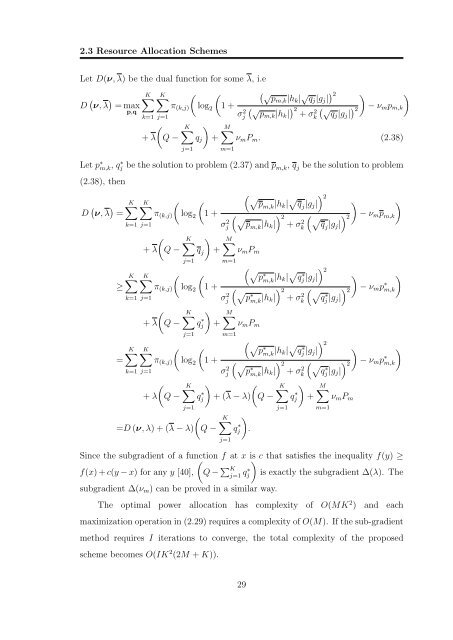Resource Allocation in OFDM Based Wireless Relay Networks ...
Resource Allocation in OFDM Based Wireless Relay Networks ...
Resource Allocation in OFDM Based Wireless Relay Networks ...
Create successful ePaper yourself
Turn your PDF publications into a flip-book with our unique Google optimized e-Paper software.
2.3 <strong>Resource</strong> <strong>Allocation</strong> Schemes<br />
Let D(ν, λ) be the dual function for some λ, i.e<br />
D ( ν, λ ) K∑ K∑<br />
(<br />
(√<br />
pm,k |h k |<br />
= max π (k,j) log 2<br />
(1 √ q j |g j | ) 2 ) )<br />
+<br />
p,q<br />
(√<br />
pm,k |h k | ) 2<br />
+ σ<br />
2<br />
(√<br />
k<br />
qj |g j | ) 2<br />
− ν m p m,k<br />
k=1 j=1<br />
(<br />
+ λ Q −<br />
K∑<br />
)<br />
q j +<br />
j=1<br />
σ 2 j<br />
M∑<br />
ν m P m . (2.38)<br />
m=1<br />
Let p ∗ m,k , q∗ j be the solution to problem (2.37) and p m,k , q j be the solution to problem<br />
(2.38), then<br />
D ( ν, λ ) =<br />
≥<br />
=<br />
K∑<br />
K∑<br />
k=1 j=1<br />
K∑<br />
k=1 j=1<br />
K∑<br />
π (k,j)<br />
(<br />
log 2<br />
(1 +<br />
(<br />
+ λ Q −<br />
K∑<br />
K∑<br />
)<br />
q j +<br />
j=1<br />
π (k,j)<br />
(<br />
log 2<br />
(1 +<br />
(<br />
+ λ Q −<br />
K∑<br />
k=1 j=1<br />
K∑<br />
j=1<br />
q ∗ j<br />
)<br />
+<br />
π (k,j)<br />
(<br />
log 2<br />
(1 +<br />
(<br />
+ λ Q −<br />
K∑<br />
j=1<br />
q ∗ j<br />
(<br />
=D (ν, λ) + (λ − λ) Q −<br />
σ 2 j<br />
( √pm,k<br />
|h k | √ 2<br />
q j |g j |)<br />
) )<br />
( √pm,k<br />
) 2 ( √qj ) 2<br />
− ν m p m,k<br />
|h k | + σ<br />
2<br />
k<br />
|g j |<br />
M∑<br />
ν m P m<br />
m=1<br />
σ 2 j<br />
( √p<br />
∗<br />
m,k<br />
|h k | √ q ∗ j |g j|) 2<br />
)<br />
( √p ) 2 (<br />
∗<br />
m,k<br />
|h k | + σ<br />
2 √q ) 2<br />
− ν m p ∗ m,k<br />
∗<br />
k j |g j |<br />
M∑<br />
ν m P m<br />
m=1<br />
σ 2 j<br />
( √p<br />
∗<br />
m,k<br />
|h k | √ q ∗ j |g j|) 2<br />
)<br />
( √p ) 2 (<br />
∗<br />
m,k<br />
|h k | + σ<br />
2 √q ) 2<br />
− ν m p ∗ m,k<br />
∗<br />
k j |g j |<br />
) (<br />
+ (λ − λ) Q −<br />
K∑<br />
j=1<br />
q ∗ j<br />
)<br />
.<br />
K∑<br />
j=1<br />
q ∗ j<br />
)<br />
+<br />
M∑<br />
ν m P m<br />
S<strong>in</strong>ce the subgradient of a function<br />
(<br />
f at x is c that satisfies the <strong>in</strong>equality f(y) ≥<br />
f(x) + c(y − x) for any y [40], Q − ∑ )<br />
K<br />
j=1 q∗ j is exactly the subgradient ∆(λ). The<br />
subgradient ∆(ν m ) can be proved <strong>in</strong> a similar way.<br />
The optimal power allocation has complexity of O(MK 2 ) and each<br />
maximization operation <strong>in</strong> (2.29) requires a complexity of O(M). If the sub-gradient<br />
method requires I iterations to converge, the total complexity of the proposed<br />
scheme becomes O(IK 2 (2M + K)).<br />
m=1<br />
)<br />
)<br />
29

















